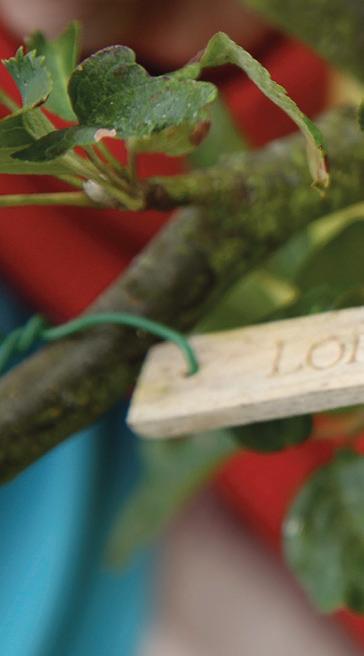
12 minute read
LOCAL TO THE CORE The native
When it comes to varieties of apples, Stamford is renowned as an epicentre of epicureanism, with over 40 local varieties historically cultivated around the town. Many of those varieties have been lost over time, but Stamford Community Orchard Group is seeking to resurrect and preserve as many varieties as possible, even using techniques like DNA testing...
Perhaps you have an apple tree in your garden. If so, do you know the variety of fruit it yields? It’s worth checking because among Stamford’s many other quirky facets - from its cameos in film and on TV, its role as the home of the Burghley Horse Trials, and its reputation as one of the best places to live in the UK - it’s also renowned as the home of a great many heritage apple varieties.
Advertisement
Autumn sees Apple Day celebrated by the Stamford Community Orchard Group - SCOG for short - and having enjoyed a bumper crop in their orchard in recent years, they’re also hoping for bumper support as they invite the public along to discover more about the area’s apple growing heritage.
Modern practices in the livestock sector of agriculture favour commercial breeds which yield the most meat or milk, and grow the quickest.
Likewise, our supermarkets stock few of the 2,300 different varieties of apple on display at Kent’s National Fruit Collection Kent, and the 7,500 cultivars of apples overall.
The UK orchard fruit market is worth £681m, with 19,000 hectares dedicated to growing apples and pears. We produce just 575 tonnes of apples, then import 1,500 tonnes from the EU and 2,200 tonnes from outside the EU.
Braeburn, Gala and Golden Delicious are the three most common varieties grown and sold in volume for the UK market, both at home and abroad.
So, shockingly, only 14% of the apples we consume in this country are grown here, and what’s worse, sales of varieties traditionally associated with English orchards - Granny Smith and Cox - are down between 30% - 35%, as supermarkets favour volume and uniformity over heritage.
Take a Cox apple tree, in good health. Of the apples it produces, only 65% or so of the fruit harvested will be deemed ‘class one,’ the best looking, and the ones that the supermarket will sell to the consumer. For a modern variety such as Gala, that figure rises to as high as 90%.
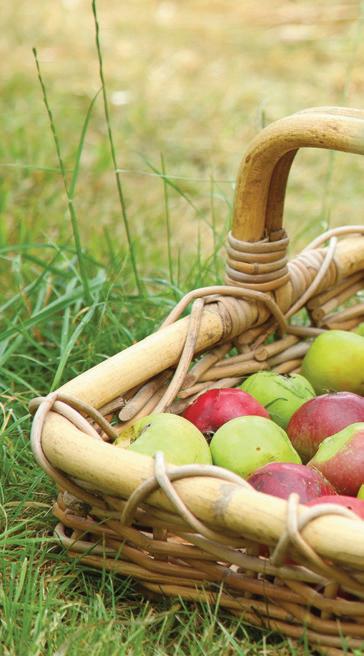
For that reason, the humble Cox has fallen out of favour, but worse still, many varieties have become all but ‘extinct.’
Fortunately, heritage apple varieties still have a few champions left fighting their corner, especially in Stamford, where a group of volunteers formed the Stamford Community Orchard Group around 16 years ago.
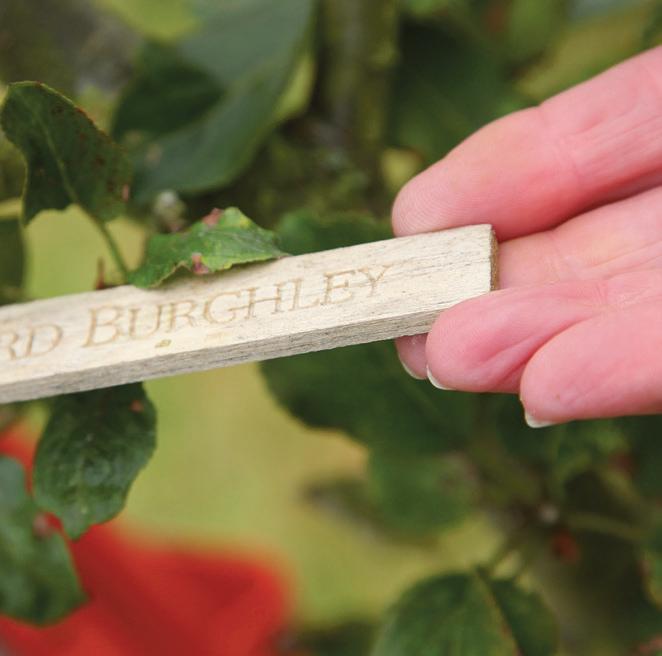
“Commercial varieties of apples have muscled out some local ones, and whilst many towns had their own ‘local’ apples, Stamford was quite prolific. We believe the town has over 40 local apple varieties, of which about seven remain,” say Annie Hall and Mark Davies, chair and treasurer for SCOG.
“The town’s heyday for apple production was around the 1850s. Many acres around the town were dedicated to fruit growing - an activity which was popular at the time anyway.”
“The town has good soil, albeit with pockets of heavier clay soil which doesn’t drain quite as well, and it had a good railway connection for moving fruit around the country.”
Gradually these orchards were built on, with apple trees replaced by new houses. But their legacy remains, in the form of local varieties from Stamford and Rutland - Ketton was a particularly well-regarded apple growing area.
SCOG is a non-profit group, comprising about 40 ‘friends’ with a committee of 12 plus various other supporters. Its mission statement is to rediscover Stamford’s lost apple varieties, and to ensure these are preserved for future generations by planting them in local orchards.

From this overriding goal came the creation of a community orchard on Stamford’s Christ Church Close in the town. The orchard covers around a quarter of an acre and comprises around 48 trees and already contains no fewer than 40 varieties of apple - many local to the area.
The ‘community’ in the group’s name refers to the fact that anyone is invited into enjoy the trees and to try the odd apple. A noticeboard outside the orchard provides a guide to the different varieties on display, and where they can be found in the orchard. >>
Above/Left: Lord Burghley is one of 40 apple varieties local to Stamford. Many varieties have been lost over the years because of national supply chains and the loss of kitchen gardens and orchards to more urban gardens.
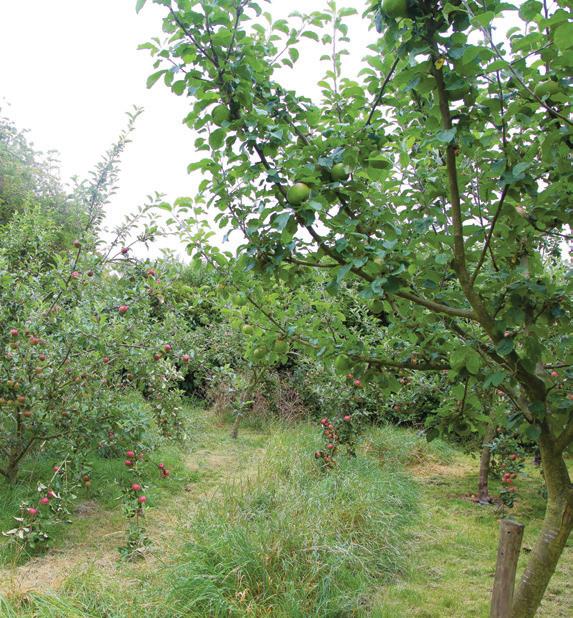
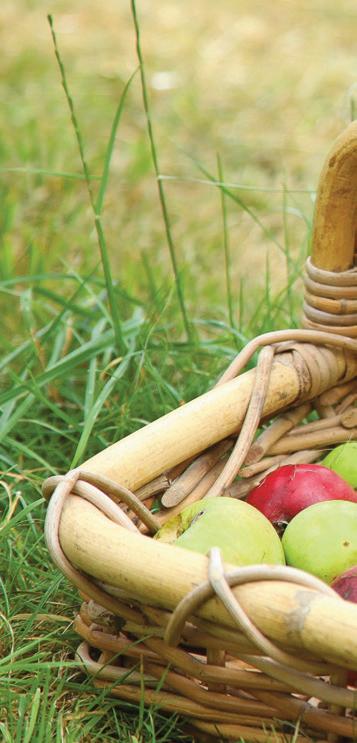
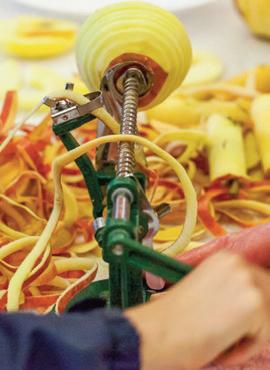
Top/Above: The orchard covers around a quarter of an acre and comprises around 48 trees and already contains no fewer than 40 varieties of apple - many local to the area. The group is hoping that its October Apple can go ahead, which will help gardeners identify their own varieties.
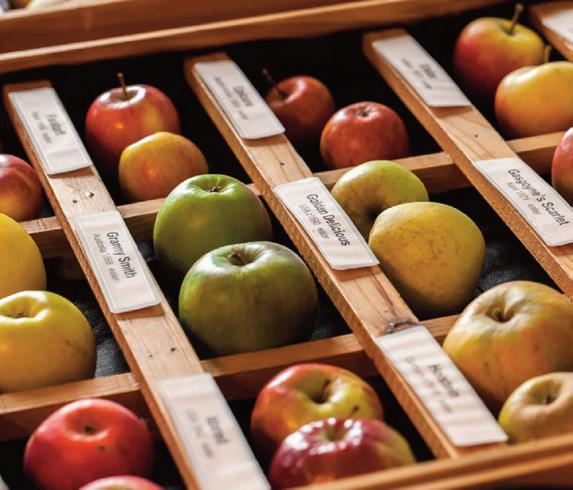
One of the nicest aspects of Stamford and Rutland is the number of older properties in the area, and often country properties with larger gardens feature establish fruit trees.
So if you’ve an apple tree in your garden but you’re unsure of the variety of fruit it yields, a trip to the orchard may solve the mystery. If not, group’s Denis Smith has an absolutely encyclopaedic knowledge of apple varieties and is SCOG’s resident apple guru.
If you’re still struggling to identify your heritage apple, the group can even help with DNA testing, working with the Brogdale Research Centre in Kent, established, like SCOG, to curate England’s heritage fruit varieties and ensure they don’t become extinct. SCOG also has two further sites for growing apples; a nursery on Queens’ Walk and an allotment on Uffington Road, from which the group also offers trees for sale.
One of Denis’s skills is grafting heritage varieties from scions - a piece of last year’s growth with three or four mature buds -
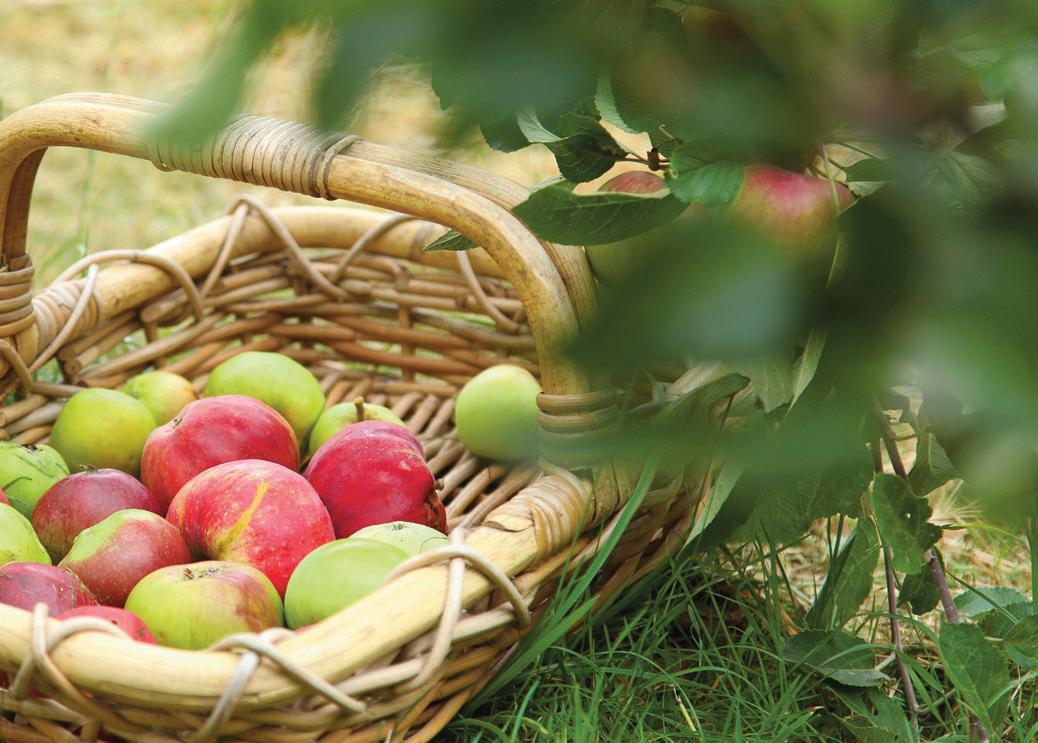
onto existing rootstocks. The group regularly participates in so-called ‘Scion Swaps’ with other groups in the East Midlands.
In addition, SCOG also holds workshops and ‘how to’ sessions detailing how to grow apple trees, conduct grafting, and covering subjects like how to prune and manage orchard trees. They’re not the only events in the group’s calender, either.
Autumn usually sees SCOG celebrating Apple Day, another exercise in identification and in offering its varieties for sale, as well as a celebration of the fruit itself. This is usually held in October at Stamford Arts Centre and attracts around 1,200 visitors. The group displays over 200 varieties of apple and will draft in its own apple gurus, as well as visiting experts to identify apple varieties from your garden from just an apple, a branch & a couple of leaves.
Heritage variety apple trees are also offered for sale on the day, and there are various stalls covering gardening, conservation and permaculture - beekeeping for example - to enjoy. Perhaps best of all, though, local catering students will be creating fruit pies for the public to enjoy too. Other demonstrations at the vent include apple pressing and cider making.
Whether the event will take place this year remains to be seen, but advice frm the group is always available via email.
The group has its own apple press purchased with lottery money that members of the public can hire, along with what’s known as a scratter. >>

>> This is a device that reduces apples down to about a quarter of an inch ready for pressing. A further SCOG event will take place in January, too, as the group celebrates Wassail, an Anglo Saxon tradition where groups would gather in orchards to sing songs to the trees in order to promote a good harvest for the coming year.
The term ‘wæs þu hæl’ translates as be thou hale, or be in good health. Stamford’s modern interpretation involves banging wooden spoons on saucepan lids, drinking presence of nature.
cider and eating apple flapjack - just about the level of organised religion I can cope with - whilst Stamford-based choir Wovan Chords will attend too, to sing folk songs.
An ancient tradition it may be, but it’s also apples which are left for local wildlife
a lighthearted way to celebrate the group’s dedication to keeping heritage varieties of apples in the town and no matter how quirky it seems, it clearly works as the group is celebrating a bumper harvest in 2016.
It’s little wonder, since conditions this year we’ve had a warm spring with plenty of summer rain. It takes a fruit tree around five years to yield good fruit, so varieties planted by SCOG a few years ago are just beginning to proliferate an abundant harvest.
Fruit trees can pretty much be planted all year round, but in the winter, they make roots, whilst in the summer, they produce leaves and fruit, so purchasing heritage trees from the group’s nursery means you can plant them in your garden or create an orchard of your own during a mild autumn.
If you are trying to establish a fruit tree or two (or more), it’s difficult to overwater them. A bucket of water a day is about right, and watering should continue as the fruit begins to swell. Sunny, sheltered spaces work best, and soil with good draining properties is preferable - some of SCOG’s orchard soil is clay based, and therefore quite heavy.
Trees should be pruned each year - an entire subject in itself, and once you see a few windfall apples, you can harvest your crop to keep in a cool dark place - cellars are ideal, though good ventilation is important.
The best orchards are those which are not just designed for fruit growing, but which yield other soft fruit, and have the odd beehive and areas to sit and enjoy the

SCOG’s orchard itself is looking especially lovely, with other fruit bushes planted along the edges of the site, and areas of grass kept deliberately long to promote biodiversity, with wild flowers proliferating and windfall have been ideal for fruit tree production;
to enjoy.
There are so many reasons to enjoy SCOG’s activities - whether you’re a gardener, an historian, a keen cook or a nature lover.
Preserving Stamford’s apple varieties means preserving a piece of the town’s heritage, too, not to mention promoting the slow food movement and enjoying home grown food. A community orchard which the whole town can enjoy is a great resource, so we’re happy to recommend going along to the group’s Apple Day this month.
After all, when it comes to apples, and when it comes to the crunch, it’s good to preserve Stamford’s past. n
The Stamford Community Orchard Group, will resume meetings after lockdown on the third Wednesday of the month from 7.30pm at The Crown Hotel, call 01780 484180 or see www.scog.org.uk.
STAMFORD’S LOCAL APPLE VARIETIES
1. Lord Burghley Brisk, aromatic quality; plenty of sugar, juicy, firm flesh.
2. Barnack Beauty Strong, brisk taste, slight richness and aromatic quality; dense flesh.
3. Allington Pippin Mellows to an intense fruity drop of pineapple taste, although still fairly sharp by Christmas.

4. Peasgood Nonsuch Brisk, juicy. Cooks to sweet, delicately flavoured puree. 5. Brown’s Seedling Quite sweet, rich, good flavour in December. Cooks to sweet bright lemon puree.
Tasting Notes courtesy of Mark Davies, SCOG.



TRAVEL
GREAT ESCAPES
Don’t go... stay! That’s the message of the UK tourism industry as it remains keen to recover as quickly and fully as possible from lockdown and a lost season of trade. We agree... we’ll happily forgo airports, departure lounges and jetlag in favour of a luxury break to nearby Norfolk... after all, if it’s good enough for royalty, it’s good enough for us! Here’s where to stay and what to do!

Words: Rob Davis.
LET’S TALK ABOUT TOURISM. We all like to get away, and in the past decade or two we’ve enjoyed an unprecedented availability of air travel with cheap carriers driving down the cost of flights.
That’s led to more people than ever going abroad. And that’s bad for UK tourism. It’s bad for the environment - all that air traffic - and it’s lead to a false notion that to get away from it all we have to endure departure lounges, long haul travel and jetlag.
Better to arrive than travel... Nope. The UK has much to offer tourists, not least in locations like the Cotswolds and the Lakes, but closer to home. Norfolk - and specifically the North Norfolk Coast - has much to offer visitors.
That’s why, back in 2014, Emma Mason created Barefoot Retreats. The co-founder, owner and director created the business in the discretely affluent area of North Norfolk, curating a portfolio of over 100 self-catering retreats for short breaks or holidays, for anywhere between two and 24 guests.
For Couples or Families... Some of the properties in the company’s portfolio are boltholes for a romantic getaway. Some properties are large enough to accommodate entire families and large groups for special occasions.
Alongside quirky, luxurious or just plain quaint properties, Zoe and the team offer a concierge service for guests, enabling them to provide not just a nice looking place to stay, but recommendations for places to dine, provision of private dinner parties, picnics or beach barbecues, spa days and beauty treatments, babysitters, dog walkers, even pleasure flights in helicopters or hot air balloons.
The Joy of North Norfolk After just an hour or so travelling, you’ll be transported to a county of expansive coastlines, wild and wonderful scenery, quiet country pubs offering proper food, history, and really good shopping. Guests enjoy a welcome hamper, logs and kindling for a
Above: Blickling Hall is North Norfolk’s National Trust-owned Jacobean mansion, just one of the attractions to enjoy in the area whilst you’re enjoying luxury accommodation courtesy of Barefoot Retreats. From romantic boltholes to family-sized properties, you’ll find self-catering accommodation that will prove it’s better to arrive than travel.










